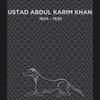 Despite a career spanning decades as both a performer and music theorist, Ustad Abdul Karim Khan rarely played in front of a microphone. This album is just an instance in his artistic life, recorded in Bombay only a handful of years before his death but it shows a singer in his prime. His command of his voice and reverence for his art comes through the fog of the 78 recordings with a vigor undiminished by time or culture.
Despite a career spanning decades as both a performer and music theorist, Ustad Abdul Karim Khan rarely played in front of a microphone. This album is just an instance in his artistic life, recorded in Bombay only a handful of years before his death but it shows a singer in his prime. His command of his voice and reverence for his art comes through the fog of the 78 recordings with a vigor undiminished by time or culture.
I was surprised by Important Records’ move to release a compilation of Indian classical music recorded in the ‘30s. While the influence of such music on 20th century composition is considerable, particularly on such touchstones of minimalism such as La Monte Young and Terry Riley, it still seems like a leftfield release for Important. My knowledge of Indian classical music is limited but Ustad Abdul Karim Khan’s style sounds quite different to the few Indian artists I would be familiar with. The earthy vocals of Pandit Pran Nath or Amir Khan are a far cry from Kamir Khan’s almost androgynous voice. His voice lifts the words up on a cloud to the heavens whereas the Ragas that usually get played in my house tend to swallow up the ground.
Unfortunately, due to recording limitations at the time, the pieces clock in at around four minutes each; there are no lengthy explorations of the various pieces. Yet, in such short bursts, Kamir Khan demonstrates his vast skill with an almost superhuman capacity to dance across the complex scales like ordinary singers do with a simple "do re mi." Performing the Jhinjhoti raga "Piya bin nahin avata chain," Kamir Khan sounds like a celestial being. His voice, radiant and light, twists impossibly through the quick delivery of the words. It is utterly intoxicating. Elsewhere, his haunting performance on "Jamuna ke tira kanha" shows his deep control of his singing and demonstrates the powerful emotional content of this music.
In addition to Kamir Khan’s inimitable voice, he is joined by a group of equally talented musicians. Two tampuras and a tabla form the base of many of the works; the drone of the tampuras insistent and steady, filling in the gaps where Kamir Khan’s voice cannot reach. Yet it is Shankarrao Kapileshwari’s harmonium that stands out throughout 1934-1935; his playing closely follows Kamir Khan’s vocal acrobatics, at times slow and monolithic but Kapileshwari can really move when he needs to. The album finishes with "Nach sundari karun kopa," a Sindhi Kafi raga that stands out stylistically from the others in this collection. The recording documents an ecstatic symbiosis of men and music; all performers coming together and rendering the notes and rhythms into something godly.
While these recordings have been made commercially available in India, this is the first time they have been widely available in the west. Despite the age of the recordings and the fact that many original recordings from the same time were destroyed during World War II (they were made by a German recording company, Odeon), these have survived and have been restored to a point where they sound as good as they possibly can get. Bundled with the CD is a booklet containing a detailed essay on Karim Khan and the recording industry in 1930s India, altogether it is a fantastic release and I can only hope that this is the first of many similar albums from Important.
samples:
- Gujri Todi: "Beguna gunga ga" (drut)
- Gujri Todi tartan: "Dim Dara Dir Dir"
- Sindhi Kafi: "Nach sundari karun kopa" (ektal)
 
Read More

